Build a Rube Goldberg Machine with Kids
So, are you interested in building a Rube Goldberg-style machine with little kids? This post will give you a few tips and ideas to make your own complicated machine.
This project has long been on my to-do list with my kids. We are long-time fans of marble runs (see the resources page for recommendations), and extending our love for rolling balls and ramps into the world of Rube Goldberg was a no-brainer. And triple hurrah for projects that celebrate STEM and STEAM learning. We were on the hunt for easy Rube Goldberg ideas, watched a few videos, and came up with this fun solution that works for young children.
About Rube Goldberg
For the uninitiated, Rube Goldberg was an American Pulitzer Prize winning cartoonist, sculptor, author, engineer, and inventor, and his work is a classic example of the melding of art and science. Goldberg began his career as an engineer, and later became a cartoonist who drew elaborate illustrations of contraptions made up of pulleys, cups, birds, balloons, and watering cans that were designed to solve a simple task such as opening a window or setting an alarm clock. Interestingly, Goldberg only drew the pictures, and never built any of his inventions. However, these pictures have since served as inspiration for makers and builders who want the challenge of making wild inventions to solve everyday problems. 
And apparently, Rube Goldberg is a now an adjective in the dictionary! You can read more about Goldberg here.
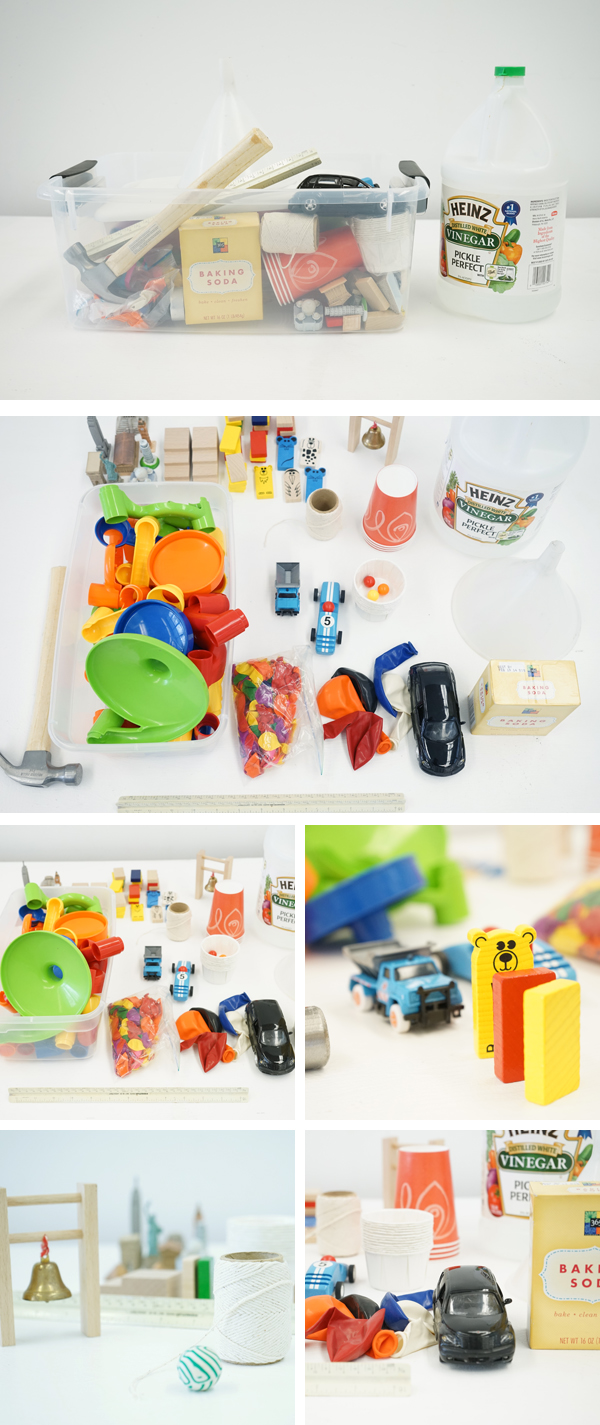
Step 1: Get Inspired
First things first, you’ll want to watch some Rube Goldberg contraptions in action to get inspired. My kids and I LOVE this video from OK Go. It’s incredible complicated, but oh-so-amazing, so don’t think for one hot second that you’ll be able to replicate this with little kids. I’ll add more inspiring videos below.
Step 2: Solve a Problem
Next, come up with a simple problem that you’re trying to solve. For example:
- Ring a Bell
- Pop a Balloon
- Open a Door
- Shut a window
- Put out a candle
Once you have a problem sorted out (and don’t worry – you can change this later if you want), gather supplies…
Step 3: Gather Supplies
You can print out the following list here.
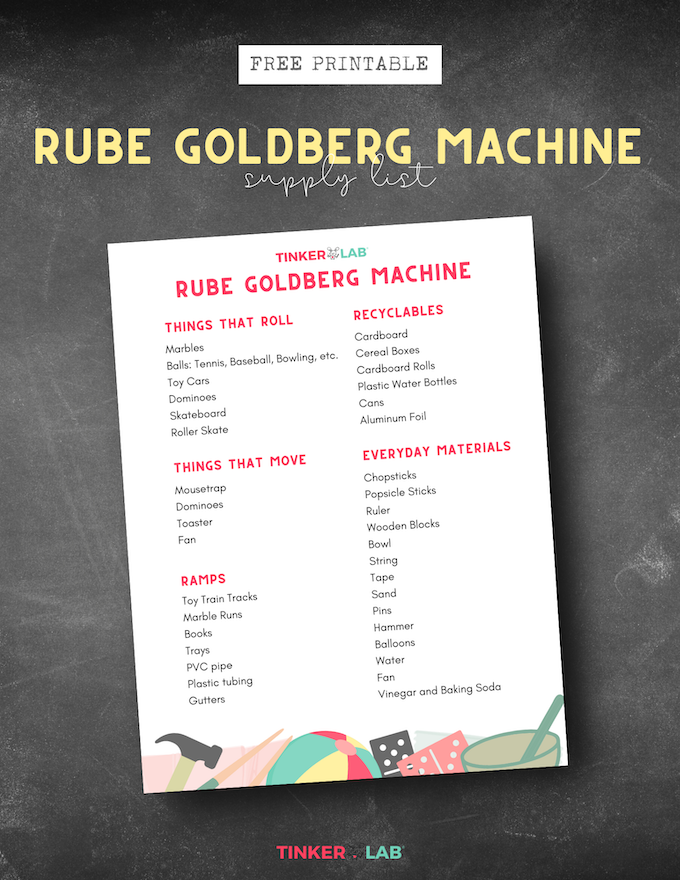 Collect a bucket-full of supplies and then lay them out so they’re easily seen. These can largely be found in your home or classroom — start with what you have! You will most likely start with some of these basics, and then forage your home or classroom for more supplies as you go. Here are some ideas to get you started:
Collect a bucket-full of supplies and then lay them out so they’re easily seen. These can largely be found in your home or classroom — start with what you have! You will most likely start with some of these basics, and then forage your home or classroom for more supplies as you go. Here are some ideas to get you started:
Things that Roll
- Marbles
- Balls: Tennis, Baseball, Bowling, etc.
- Toy Cars
- Dominoes
- Skateboard
- Roller Skate
- Mousetrap
Things that Move
- Mousetrap
- Dominoes
- Toaster
- Fan
Ramps
- Toy Train Tracks
- Marble Runs
- Books
- Trays
- PVC pipe
- Plastic tubing
- Gutters
Recyclables
- Cardboard
- Cereal Boxes
- Cardboard Rolls
- Plastic Water Bottles
- Cans
- Aluminum Foil
Household Materials
- Chopsticks
- Popsicle Sticks
- Ruler
- Wooden Blocks
- Bowl
- String
- Tape
- Sand
- Pins
- Hammer
- Balloons
- Water
- Fan
- Vinegar and Baking Soda
Step 4: Build Your Machine!
Once you have the supplies ready, start building. While the OK Go video (and others like it) includes some pretty complex machines and concepts, keep this simple for preschoolers. The basic concept that we’re exploring is that of a chain reaction, so anything that tips something else over (and so one) is what you’re going for. Don’t worry too much about building things like pulleys and levers for young children.
Take a look at our machine to get a sense of what’s possible.
Our Rube Goldberg Machine in Action
5 Tips for Success
- Success breeds enthusiasm, so keep the steps to a minimum. You can always add more as you go.
- Keep your expectations low
- Ask your child for ideas and input
- Work collaboratively
- Aim to have fun
A Note on Failure
As you test and try out different set-ups, you’ll undoubtedly fail a few times. I could have filled a 20 minute video with outtakes from all our misses (the balloon is a good example of that). But this is great news! Failure is an intrinsic piece of the invention process, and without these mistakes we won’t learn how things really work. So embrace failure and celebrate it as part of the learning process.
Next Steps: Full STEAM Ahead
- Ask: What other simple problems could we solve?
- Ask: What materials could we use?
- Ask: Why didn’t that work? How could we fix it or try it again?
- Encourage your child to problem solve by seeking out materials and moving objects.
Did you enjoy this project? Join the semi-secret Club TinkerLab on Facebook to swap and share more ideas like this.

Inspiring Rube Goldberg Machines
Watch this one light up a Christmas tree
Learn about Rube Goldberg Machines on Sesame Street
Easy Rube Goldberg Example
More Projects like this one
DIY Water Wall, it’s like a marble run, but with water!
Activate Learning with STEAM
If you’ve been a loyal TinkerLab fan (thank you! you mean the world to me.) you’ll know that I’m happiest sharing projects that live at the intersection of disciplines. Too often we’re quick to separate science from writing or math from art, but when we seek out ways to make interdisciplinary connections, learning can be more meaningful and novel discoveries can be made.
In that vein, you may also enjoy these projects that circle around STEAM (science, technology, engineering, art, and math) ideas. This week’s theme is REACT, and you can see the other reaction-related ideas here:
Stixplosions | Babble Dabble Do
Smoosh Painting | Meri Cherry
Color Changing Chemistry Clock | Left Brain Craft Brain
Zoom Ball | What Do We Do All Day?
Glowing Hands | All For The Boys
Rainbow Reactions | Lemon Lime Adventures
Colorful Chemical Reaction | Frugal Fun for Boys
STEAM on Pinterest
You might also enjoy following my STEAM + STEM Activities board on Pinterest for more ideas like this.

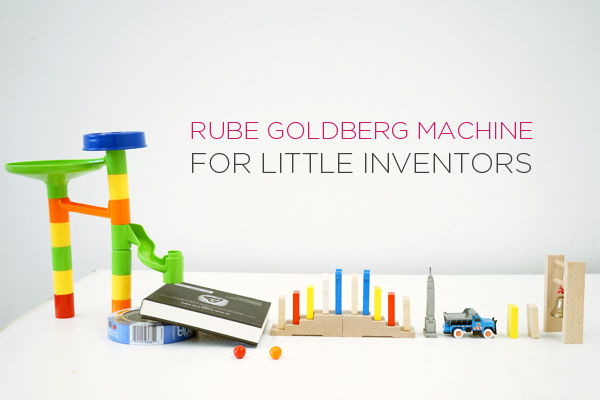

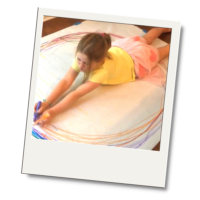
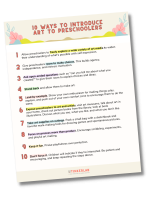
I adore this idea. I have actually wanted to make something like this ever since I was a little girl and watched that truffle-shuffle scene in The Goonies 🙂 I will definitely have to get a kit together for my little STEAM obsessed friends. Thank you!
Thank you, Cait! I’m so glad that you mentioned that AWESOME Goonies scene. How could I not have included that in this post? So memorable. Here’s a link to anyone who misses it: https://www.youtube.com/watch?v=V-Ln03xgaUc
hi
[…] Create a Rube Goldberg Machine from Tinkerlab […]
[…] Rube Goldberg Machine – Tinkerlab […]
[…] Rube Goldberg Machine // TinkerLab […]
I just happened to check out your site this morning to see what was new for art class and immediately changed my plans for K/1 science! We found materials around our classroom and borrowed some bells from the music classroom. The kids didn’t want to clean up for lunch 🙂 I promised more time for inventing this week. Thanks for the great explanation and lists, they made it easy to get started!
Are you serious, Brianna? That’s so amazing. I’m DELIGHTED that this post was helpful and that you were able to get this off the ground so quickly. Have a great day.
Oh, it was great! We had two weeks of inventing. We’re just coming off of March Break, but we’ll probably revisit it again. The activity fit in very well with the new full day kindergarten curriculum we have in Ontario, which is centred around play-based learning. If I can find a video or picture of our machines that don’t have kids in them, I’ll send you one 🙂 I’m fortunate enough to team-teach a Kindergarten-Grade 1 class part time, and my subjects are Science, Art, Health and Phys. Ed. (I do teach other subjects as well). So I’m excited to check out the other STEAM Power projects next!
I love Rube Goldberg Machines! I even have vintage toy based on his cartoons. This is a great project to try and so inventive!
Oh, I would love to see that toy, Ana. It will be interesting to see how the contraption-invention process changes as my kids get more experience with this.
[…] Rube Goldberg Machine // TinkerLab […]
Rachelle, I don’t know if I can love a post more. The pictures, the video, the ideas! The coolness of Rube Goldberg. I just love everything about this. Well done woman! Will share this week for sure.
Meri, you are the loveliest! This was a fun project to work through and the ideas that my daughter had were priceless. I wish I had the energy to compile a big video of outtakes.
i have been doing rube goldberg machines and this post was amax=zin
Super post & project for kids! It reminds me of the game Mousetrap that we use to LOVE to set up but hated the clean up part 🙂 I wonder if his work inspired that game? Also reminds me of a few scenes from the movie “Home Alone”. My daughter will really love doing this — she’s a born builder with a great sense of humor 🙂
Thank you so much for the comment Jacquie! I’ve never played Mousetrap, but have heard of it. It sounds like fun. I just looked into it, and apparently the game designer, Marvin Glass, WAS in fact inspired by Goldberg and never acknowledged him! Yikes. I forgot about that Home Alone scene. So, so good.
This is fantastic!
Have you seen the Rube Goldberg Sesame Street scene (on YouTube)??
Spent two hours building this morning!
Thanks for the inspiration.
Hi Jacq, No, I haven’t seen it! You guys are all sharing so many great scenes and I have to look for this one. Awesome! I’m so glad to hear that this inspired you. I left the pieces set up in my studio, and a friend came over and couldn’t stop playing with them. Fun for everyone!
My almost 5 year old and I just built our first Rube Goldberg invention. She loved it. I almost never write comments like this but am so appreciative for the post and ideas. We had a great time. She is now brainstorming other ones we could create.
Hi Heidi,
I’m honored that you’re leaving a comment for me. I’m so glad that this was a hit in your home, and look forward to hearing from you again!
Rachelle
[…] totally cool is this Tinker lab Engineering Kids and Rube Goldberg Machine and while you are over at Tinkerlab… did you see these solar […]
What a great blog on Rube Goldberg contraptions! Not long ago we met Rube Goldberg’s granddaughter at a science convention.What a charming lady! She has a website and runs a contest for older kids. She inspired us to write a blog on Rube Goldberg contraptions in which we included a list of great picture books for this theme. http://www.getcaughtengineering.com/brainy-zany-contraptions-stem/
We love your book and website and frequently recommend it to teachers and parents who are looking for STEM projects for younger children. Thanks for all your wonderful ideas.
Wendy
Get Caught Engineering
[…] Engineering Kids | Rube Goldberg Machine TinkerLab Using Pool Noodles to Build a Playhouse From ABCs to ACTs PVC Pipe House Building Project Engineering STEM Activity Little Bins Little Hands STEAM Challenge: Build a structure you can balance on one finger (or your nose!) Gift of Curiosity Build a Satellite NASA Jet Propulsion Laboratory How to Make Projector Using Smartphone and Magnifying Glass STEM Little Explorers Pneumatic Machine Made for STEAM Cardboard Automata Exploratorium How to Make a Water Wheel Home Science Tools Global Cardboard Challenge Imagination.org […]
This is a good idea! my 4th grade class and I are making one next week! <3
[…] about Rube Goldberg Machines, can you make one at home? (Lego rube goldberg […]
[…] will love building their own Rube Goldberg machine! // Tinker […]
[…] Rube GoldBerg Machine | Tinker Lab […]
[…] Create a Rube Goldberg Machine (check out this link) […]
[…] https://tinkerlab.com/engineering-kids-rube-goldberg-machine/ […]
[…] Get creative together. Think outside the box to create your own activities that the whole family can participate in. Use household items to create an obstacle course, think of a theme and create a scavenger hunt, or have your child pick two objects from every room in the house and create a Rube Goldberg (chain reaction) machine. […]
[…] Get creative and make a Rube Goldberg machine (Tinker Lab). This can be done with many items found around the house. Your machine […]
[…] Build a Rube Goldberg machine […]
[…] Construct a Rube Goldberg machine […]
[…] Build a Rube Goldberg machine […]
[…] Build a Rube Goldberg machine […]
[…] Build a Rube Goldberg machine […]
[…] Construct a Rube Goldberg machine […]
[…] Construct a Rube Goldberg machine […]
[…] Build a Rube Goldberg machine […]
[…] Build a Rube Goldberg machine […]
[…] Build a Rube Goldberg machine […]
[…] Build a Rube Goldberg machine […]
this is almost the coolest thing in my life.
[…] Build a Rube Goldberg machine […]
[…] Build a Rube Goldberg system […]
Idk
[…] STEM: Rube Goldberg Machine […]
[…] STEM: Rube Goldberg Machine […]
[…] STEM: Rube Goldberg Machine […]
[…] Build a Rube Goldberg machine […]
[…] Build a Rube Goldberg machine […]
this is really smart for kids like me.
[…] For more detailed instructions on making your own Rube Goldberg machine, click here. […]
[…] the contest, you can just have fun with the challenge. Read about making a Rube Goldberg here: https://tinkerlab.com/engineering-kids-rube-goldberg-machine/ and watch this video to hear about the […]
[…] that the goal is to solve a problem repeatedly. An example of a well-explained outline is https://tinkerlab.com/engineering-kids-rube-goldberg-machine/. The instructor will provide in-class support to learners in finding other resources and videos of […]
wow that was so long to read i a surpised
[…] Tinkerlab: Rube Goldberg Machines […]
[…] a Rube Goldberg machine or a paper plate marble […]
i loved it
Sooooooo goood
[…] R – Rube Goldberg Machine Making – tinkerlab.com/engineering-kids-rube-goldberg-machine […]
hi
[…] This is a great way to do something new with those unused boxes of toys! Rube Goldberg (or chain reaction) Machines help children to understand physics and are a brilliant way to develop perseverance and patience when things don’t work so well the first time. Start with a simple example of a line of dominos falling into each other, and then let children’s imaginations run wild! There are some ideas and links to videos in this old but very good resource from Tinkerlab. […]
Very nice idea. Surely this is a good activity to try.
[…] Rube Goldberg Machines and Marble Roller Coasters – Have your children look through their toys and come up with some objects that they can use to create a Rube Goldberg Machine. Or grab some leftover pipe insulation from your last winterizing project and have them create a roller coaster for marbles. Both activities provide lots of opportunities to experiment with the laws of physics! […]
hi
[…] Create a Rube Goldberg Machine […]
[…] Engineering Kids | Rube Goldberg Machine on Tinker Lab – Watch videos, get a printable supply list, and read tips for success in this post. […]
[…] Rube Goldberg Inventions Ideas for zany inventions inspired by the Rube Goldberg, the cartoonist whose ridiculous “time-savers” were more trouble to put together than the task itself ever might have been. This site offers video examples, ideas to get you started, and lists of materials you might find around the house. If you don’t have one of these items, just try something else. Maybe small books will work as well as dominoes. Try paper towel rolls if you don’t have plastic tubes. And we sure will want to see your pictures and videos for this one, so please tag us on Instagram. Just google Rube Goldberg Inventions if you want to see more. […]
[…] Rube Goldberg Inventions Ideas for zany inventions inspired by the Rube Goldberg, the cartoonist whose ridiculous “time-savers” were more trouble to put together than the task itself ever might have been. This site offers video examples, ideas to get you started, and lists of materials you might find around the house. If you don’t have one of these items, just try something else. Maybe small books will work as well as dominoes. Try paper towel rolls if you don’t have plastic tubes. And we sure will want to see your pictures and videos for this one, so please tag us on Instagram. Just google Rube Goldberg Inventions if you want to see more. […]